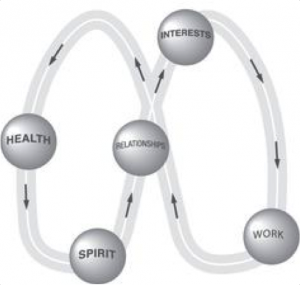The Idea of Work-Life Balance and Why We Need to Let Go of It
Written by Jessica Roshak
As a graduate student working in the Student Activities (SA) Office, we talk a lot about work-life balance. This is a topic of great importance in the field of higher education and student affairs (HESA), especially as many of us are very passionate about our work, reaching above and beyond our job descriptions. Though this is not a bad thing, it can cause us—and potentially our supervisors—to forget that we are real people juggling responsibilities and identity roles outside of our jobs each and every day. I have heard countless professionals discuss their experience with being off-balance and the practices that they have implemented since then to ensure it never happens again, and I have read articles about how to balance your life, but no one ever says what work-life balance really is. I would say that this is because there is no such thing.
When most people think of balance, they see a scale with two sides. If our lives are in balance, we are putting forth an equal amount of effort into our work and into our personal lives, causing both sides of the scale to become even with one another. This ideal is impossible and we need to stop telling our colleagues and friends to strive for this. Dan Thurmon, professional speaker and former acrobat, has another idea: living off-balance on purpose.
In his TED talk entitled, “Off Balance on Purpose: The Future of Engagement and Work-Life Balance,” he says, “Life balance is a trait that is intriguing and desirable, but also completely unrealistic…. We are constantly making readjustments, whether it is obvious or not… [and] we will never achieve balance.”
He says that we have to be off-balance in order to learn and grow, comparing the idea of balance to juggling. When he was a boy learning the act, he got the hang of juggling three balls at a time. Though this was an accomplishment, he wanted more. He decided to try four, but was very unsuccessful. Why? Because he was continuing to use the same pattern, though the task was different. This is true for us as student affairs professionals as well.
After a while, we get stuck in routines. Then, when something new gets added onto our plates—a new task, position, or issue to deal with—we try to go about our routine in the same way, thinking that we will have just as much success. Maybe something happened in your personal life such as a marriage or the birth of a child. Life has now given you another challenge, more to worry about, so it is critical that you change your pattern.
This leads to the five areas of life that we are constantly juggling: Work/school, relationships, health, spiritual growth, and personal interests. These areas are going to overlap from time to time and he argues that the more that they do, the better off you are. “A connected life pattern will help you to sustain those twists and detours as you move through life,” he contends.
Each of the five areas that we are “juggling” interact with one another constantly.
The diagram below shows just how they do so. As you can see, the five areas create the pattern of an infinity symbol, representing our infinite potential. There are time when things make sense and fit perfectly and other times when they are not—but that is okay, because each area is still connected.
So how do we make this work in graduate school? Well, this is unique to the individual, but I can tell you how I make it work for me. School/work, relationships, and spiritual growth are all very tightly connected to one another, just based on the nature of the master’s program at Baylor University. Using the cohort model, I see my friends in class three times per week while we discuss how the content we are learning relates to the larger Christian narrative. They are also great study buddies! I balance personal interests and health by getting outside and doing some hiking in our local or state parks (there are a ton of them in Texas!), most often with my husband, which adds in relationships.
The moral of this story is that we need to stop thinking about work-life balance dichotomously—we either have it or we do not. As student affairs professionals, we are jugglers of many roles and responsibilities and need to let go of the idea of work-life balance, striving to live our lives off-balance on purpose.
To watch Dan Thurmon’s TED Talk, click here.
Written by Jessica Roshak, 2nd-year HESA student

